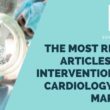INTERNATIONAL SESSIONS WITH THE MOST RENOWNED SOCIETIES WORLDWIDE Appealing sessions on the most relevant current topics in interventional cardiology will be at the forefront of a virtual, interactive event you do not want to miss! Save the date: August 2-6, 2021 Register now for FREE Learn more about the international joint sessions featured in...
Differences in American and European Atrial Fibrillation Guidelines
The recent publication of the European Society of Cardiology (ESC) and the American College of Cardiology (ACC) guidelines provided an important update on multiple aspects of the management of atrial fibrillation (AF). However, these guidelines differ in terms of management and recommendation levels. As it might be expected, most differences arose in intermediate cases—both guidelines...
The Most Read Articles in Interventional Cardiology of March
01- Surgeons’ Claim on Low-Risk Patients with Aortic Stenosis Recent randomized trials including low-risk patients showed positive results for transcatheter aortic valve replacement (TAVR) compared with surgical aortic valve replacement. Read more HERE 02- Major Cause of Myocardial Injury by COVID-19 The most common cause of myocardial necrosis in patient undergoing COVID-19 infection is microthrombi. These...
The Most Read Articles of January in Interventional Cardiology
01- New Valvular Heart Disease Guidelines with Key TAVI and Mitral Regurgitation Updates Valvular heart disease management guidelines were updated last week by the AHA and the ACC. Read more HERE 02- High Risk Anatomy Challenges ISCHEMIA Outcomes According to this recent analysis published in JAHA, patients with stable Ischemic heart disease and high-risk anatomy benefit from revascularization...
Current DES Performance: Is There Room for Improvement?
Head-to-head comparison of current drug-eluting stents (DES) showed contradictory results that led us to believe, for years, that we had reached a plateau. This feeling was also fostered by the disappointment caused by Absorb and bioresorbable-polymer stents. However, this recent article featured in JACC Interventions shows a light at the end of the tunnel with...
Latest News on AHA/ACC Primary Prevention Guidelines
Most cardiovascular diseases and mortality come down to 4 years of unhealthy habits (smoking, poor diet, obesity and sedentarism) and 3 major risk factors (cholesterol, hypertension, and diabetes). Ideal cardiovascular health, defined as absence or control of these 7 factors, is far less frequent than we might believe. It is estimated that 87% of the...
Diabetes and Peripheral Vascular Disease: Old Drugs, New Evidence
This paper, recently published in JAHA, showed that patients with type 2 diabetes mellitus exhibiting lower-limb vascular disease benefit from combining cilostazol and clopidogrel. Treatment for at least 6 months with clopidogrel (75 mg/QD) plus cilostazol (100 mg/BID) significantly reduces ischemic events—including stroke, infarction, and death from vascular causes—compared with clopidogrel monotherapy. Adding cilostazol reduces ischemic events, but that...
SOLACI PERIPHERAL | 4th Clinical Case: Thoracic Aortic Dissection in Patient with Complex Arch
A new clinical case to keep learning with colleagues! Today, we present a Thoracic Aortic Dissection in Patient with Complex Arch. This is the 4th case for SOLACI Peripheral, which continues its mission: to deepen knowledge exchange among Latin American interventional cardiologists. Tell us what you think about this case using the comments section in this...
Procedural Rescheduling Criteria in the Pandemic Era
Patients with structural heart disease are at higher risk in the face of the new coronavirus infection due to both advanced age and numerous comorbidities. All variables must be taken into account when deciding whether a patient can wait (so as to minimize the risk of exposure to the virus) or their pathology must be...
The Most Read Scientific Articles of March
01- Coronavirus and the Heart: How Should Cardiologists Prepare? As the number of confirmed cases increases throughout the globe, a picture is emerging as to what the direct cardiovascular effects of this pandemic may be. Read more HERE 02- TAVR: Should Transradial Approach be the Second Access Site? Courtesy of Dr. Carlos Fava. One of...









